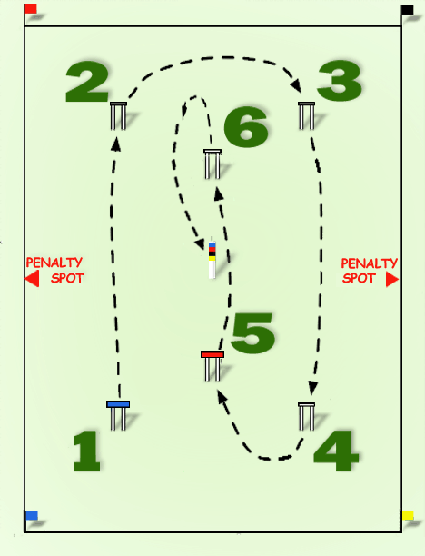
|
Back to |
| The Front Page |
| The Game |
|
"AUSSIE CROQUET" REVISITED AND REVISED |
||||||||
|
by Bob Alman photos courtesy of George Enochs and Jim Nicholls layout by Reuben Edwards Posted September 5, 2017
|
||||||||
|
||||||||
Veterans of the sport who have grown to love the traditional dominant forms of the sport tend to regard "new croquet games" with dread and loathing. Golf Croquet--though no longer new--is still strongly disparaged by purists who argue, accurately, that it is "taking over" court space at many clubs around the world. Some forecast the end of Association Croquet. Club and associations counter with the sensible argument that a "simpler" form of the game is needed to support the cost of the sport and the facilities. Might these polar positions be brought into alignment within the global sphere of our sport?
A position between those poles might do the trick. Its proponents say that "Aussie Croquet" is that sort of mid-point: that the game can be a bridge which painlessly invites Golf Croquet players into a richer realm of play, without overwhelming them all at once with the complexities of Association Croquet.
That argument hasn't been proven yet, if only because the Aussie Croquet adventure is so very new. In fact, our newly revised "universal rules" have been used only once in "serious" tournament play, as pictured below from the just-completed club competition in western North Carolina that until this year was played only in Golf Croquet and American Rules. In this case, there was a vote on whether Aussie or American Rules would be played. Aussie got twice as many votes as American Rules. Therefore....
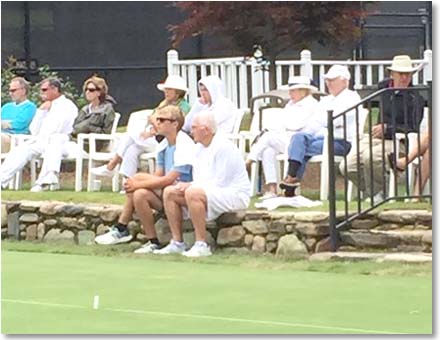
|
| Lake Toxaway is a beautiful venue, very active in summer, and part of a network of about a dozen country clubs in western North Carolina within a half-hour's drive who compete mostly--up to now--in Golf Croquet. Almost 1500 people in those clubs play croquet! This first club championship in Aussie Croquet drew a full compliment of spectators, learning the unfamiliar rhythms of the new game. |
What are "universal rules?"
The core group of revisers of Jim Nicholls' original rules recently published here--which included Nicholls himself--decided to write the Aussie Croquet rules in everyday language to encourage players not affiliated with national sports organizations to try out the game themselves, without being burdened with croquet jargon. Theoretically, garden croquet and nine-wicket advocates could understand our rules sufficiently to play them in any environment.
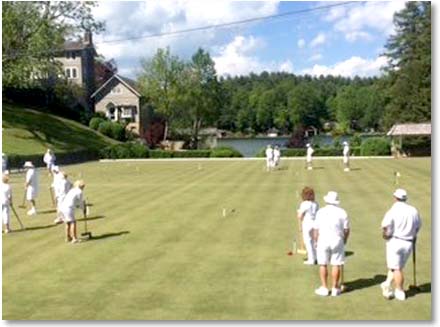
|
| Fewer than five percent of the nearly 1500 croquet players in a dozen country clubs with croquet courts on the mountainous plateau of western North Carolina play American Rules or Association Croquet. With Aussie Croquet spreading to those clubs, the region will be an ideal laboratory for testing whether the new game will have the effect of encouraging more of them to "advance." |
After publication of the first version, more experience in playing the game, and responding to comments from players in other countries who have tried it out, our "revisers" were surprised by the many improvements and clarifications we could make in the rules without making them any longer. Our core group after much debate settled on the revised rules below, but only after agreeing to allow for event directors' discretion in using some "advanced" variations.
What does "momentum" look like?
The first indication is the instant interest the game draws, especially from Golf Croquet players who know no other form of the game. Frame by frame, it looks exactly like Golf Croquet, and it retains the style of play they already know--with all the players remaining on the lawn because their turn is coming up soon, in regular rotation.
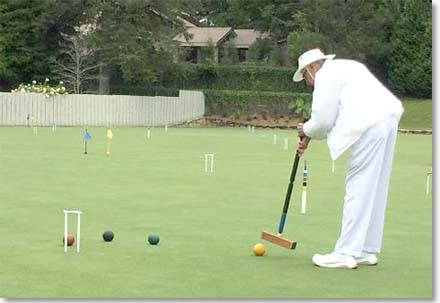
|
| Grady Price had to decide how to attack blue in the rotation above. Les Avera won the Aussie Croquet club championship. |
What they haven't seen before, however, is the extra shots the striker wins by roqueting the other balls (no more than once each turn). And spectators can figure out on their own, just by watching, exactly WHY the striker did that--whether to score a hoop, to separate opponent's balls, or to feed partner roquets in his next turn. From their own foundation in Golf Croquet, they're likely to tell themselves, "I can do that!" and want to try it for themselves. There's no question that in this sense--giving Golf Croquet players a more interesting and challenging game--Aussie Croquet works.
Aussie Croquet as a transition strategy?
| THE ANTHROPOLOGY OF THE GAME |
|
Two distinct tribes have emerged in the sport of croquet, and they don't mix very well. Their differences in style and sensibility are at least as great as those between soccer and American football. One tribe is social and highly interactive; the other is fundamentally intellectual and solitary. The one encourages and invites chatter on the lawns; the other requires long periods of solitary play, or sitting on the sidelines watching a similarly solitary opponent. The social and interactive form is called Golf Croquet; the opposite form is known as Association Croquet. Tribal loyalties in croquet are intense and enduring. The few players who compete in both tribes risk the everlasting emnity of their fellows.
|
Jim Nicholls told me he was amazed at how quickly the players at the Ponte Vedra Croquet Club took up the game, which he created as a personal and--he thought-- temporary adaptation of Ricochet to his local needs. Almost all the Golf Croquet players preferred Aussie. "The only game now played at the PVCC's weekly Wicket Women and Thursday Twilight (Pizza and beer) is Aussie," Nancy Avera, the creator of Wicket Women, told me. It was Nancy who then took the game to Toxaway, where she and her husband Les live in the summer, and quickly enrolled George Enochs, a self-confessed "croquet missionary," who had introduced croquet to Toxaway ten years ago as the first mountain club to build croquet lawns.
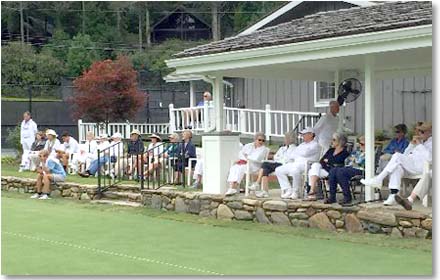
|
Most of the residents of these clubs return to warmer climes before the end of October. Before then, George Enochs plans to offer an Aussie Rules clinic at Lake Toxaway for two representatives from each of the other 11 mountain clubs..."so they can take the game back to their own clubs and teach it over the winter."
John Curington, builder, owner, and manager of the seven-lawn Ponte Vedra club, told me he plans to change his introduction program to "one game of Golf Croquet, after which they switch to Aussie." He's also planning a series of lessons in Aussie Croquet at PVCC, with the other clubs nearby invited to attend.
Meanwhile, on the other side of the globe....
Impressed with his own results in America, Nicholls took the game back to his club in Wagga-Wagga, where a group of players there quickly started regular winter-time play with the game. When people ask about his four-month sojourn in north Florida, one of the big items is Aussie Croquet. He writes from Australia, "I'll be heading to Brisbane next weekend (for the Australian Croquet Association board meeting) and will have the opportunity to discuss the various ways in which clubs are utilising different versions of croquet to attract and build (and retain) club memberships and develop player skills."
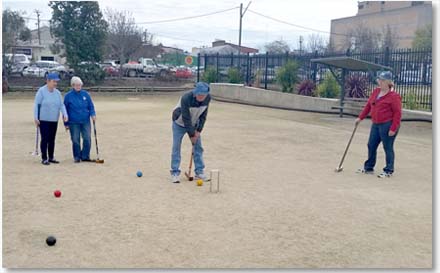
|
Jim Nicholls spontaneously "invented" the Aussie Croquet adaptation of Ricochet during his four-month sojourne in Jacksonville as croquet pro in the 2017 high season. He writes from Australia, "Here in Wagga Wagga a group of new members have taken a shine to Aussie Croquet. They say they enjoy it more than Golf Croquet as it makes them think a bit more. " The winterized lawns aren't pretty, but Jim says they play well enough.
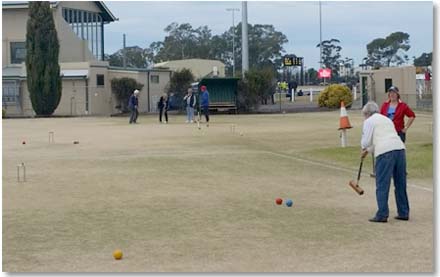
|
"Given the changes in croquet," Nicholls comment, "with Golf croquet now the more popular entry point, I believe that we need to redesign the pathway for new comers to progress through the various codes to discover which one suits them."
Nicholls had already asked for an "advance copy" of the revised rules below to publish in the ACA's monthly newsletter.
Nicholls recognizes an important aspect of Aussie Croquet is that, like Golf Croquet, it invites competitors to stay on the lawns for the entire game, and stay engaged. He's considering exactly how to use Aussie as a transition to Association Croquet: "I have yet to 'experiment on the lawn' but have given some thought as to how to introduce the croquet shot and still keep the game interactive.
"The obvious answer is to retain the rule of deadness within a turn to limit length of break. I believe this would work well for most beginners, however the more tactical and skillful players could easily learn how shut out an opponent and make the game very one sided, in their favor--making them an excellent candidate for the longer and more complex version of croquet." (Presumably, the losers in the above scenario could keep playing Aussie Croquet!)
Can Aussie Croquet help the sport survive and succeed?
Nicholls noticed right away, at Ponte Vedra, how easy it was to switch from Golf Croquet to the other game: "One of the advantages I had at PVCC is that I could take a group of beginners through the basics and have them playing Golf Croquet at the end of an hour--whilst other members were playing Aussie Croquet on the court next to us. This provided a wonderful demonstration of the different versions and made it easy to explain the natural progression from Golf Croquet to Aussie."
But where do you go from Aussie? Thoughtful readers will notice that the "transition" to American Rules is much simpler than to Association Croquet. American Rules already has rotation as well as deadness. On the other hand, without rotation, break-building will be a more difficult task--which might help to retain the attention of the novices long enough to have them make the longer leap to Association Croquet.
The leap is actually a large one: from constant "pat-and-chat" engagement on the lawns in a social sport, to solitary play alternating with equally solitary out-player rest on the sidelines.
Martin French, former long-time Secretary-General of the World Croquet Federation, has trained himself to have a very long view of the prospects of the sport and hesitates to deliver forecasts himself or to credit the dire critiques of long-time devoted players of Association Croquet fearful of its demise. "The judgement of existing croquet players on the relative merits or dangers of these games doesn't mattter. We have to allow new players of these game variants to show us what works for them. We'll see whether and how many trickle through into Association Croquet."
Give all the human preferences and propensities corresponding to the different styles of croquet, deliberately embracing several games on the same lawns and with the same equipment just might be the correct recipe for the sport's long-term survival.
|
AUSSIE CROQUET Universal Rules
This two-sided game is played on a 6-hoop court of any size. All the shots are exactly the same as those in Golf Croquet, but this game calls for more advanced mallet and ball skills, partner collaboration, and forward planning. The game may be played with satisfaction by players at all levels of proficiency.
Object of the Game
Overview of the Rules The game starts with each ball in turn being hit from halfway through the first hoop--the one with the blue top. Each turn is only one shot, unless bonus shots are earned. Bonus shots are earned when the striker ball...
The striker ball may hit any of the other three (object) balls only once during a turn. There is no "croquet shot" in this game; that is, when a hit is made, the striker ball does not lift to contact to the hit ball; striker plays its two bonus shots from the position it achieved after the hit. Bonus shots do not accumulate. Only the last earned can be used. After the striker ball hits a dead ball, the turn ends, all balls affected after the fault was made are replaced to their former positions, and the striker ball is placed on the penalty spot of the opponents' choosing. If the striker ball goes out of bounds at any time during its turn, the turn ends and the striker ball is immediately marked in on the boundary margin (uniformly either nine inches or three feet, by the event director's choice.) The striker ball may hit other balls out of bounds and still earn two bonus shots. Any balls hit out of bounds are placed on the boundary margin after completion of the turn (either nine inches or three feet, at the director's discretion).
Rover Balls
Bonus Shots
Dead Balls
Faults
Playing out of Turn
The Course Directors' Options The End Game: A challenging option allows Rover two bonus shots after hitting another ball, but only one shot to hit the peg; if Rover hits the peg accidentally or deliberately on the second shot, a penalty is invoked. Boundary Margins: A nine-inch margin, as in American Rules, is the most challenging. The three-foot boundary margin is consistent with Association Croquet. Court Dimensions: The game can be played satisfactorily on reduced-size courts.
|
George Enochs, Jim Nicholls, John Curington, Nancy Avera, Jon Diamond and Bob Alman carried on an intense month-long review of these rules and their revision through a vigorous exchange of viewpoints with an overriding commitment to both clarity and brevity. All of it was done with a joint determination to limit ourselves to "everyday English" understood not just on both sides of the Atlantic, but in gardens, back yards, public parks, and everywhere any form of "croquet" is played.
